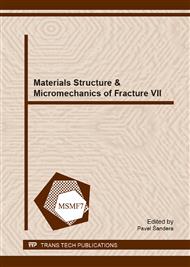p.3
p.14
p.22
p.30
p.39
p.43
p.47
p.51
Influence of Microstructure, Environment and Temperature on Fatigue Crack Propagation in 2XXX Aluminium Alloys
Abstract:
Aluminum alloys, widely used for constitutive parts of aircrafts are confronted to a wide range of temperature depending on altitude and climate, from room temperature on the ground down to some 223K at high altitude. The fatigue crack growth behavior of two new generation aluminum alloys, 2024A in T351 temper and 2022 in T351 and T851 tempers, have been investigated at both temperatures. It is shown that temperature and air humidity do not affect the crack growth resistance of the peak aged 2022 while these two parameters widely influence the crack growth in the under-aged alloys which exhibit in cold air a crystallographic retarded propagation similar to that in vacuum. The respective role of microstructure, temperature, atmosphere residual humidity and crack closure is discussed on the basis of a preexisting modeling framework for environmentally assisted fatigue.
Info:
Periodical:
Pages:
22-29
Citation:
Online since:
November 2013
Authors:
Price:
Сopyright:
© 2014 Trans Tech Publications Ltd. All Rights Reserved
Share:
Citation:


